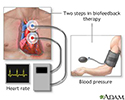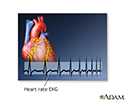Biofeedback
Biofeedback is a technique that measures bodily functions and gives you information about them in order to help train you to control them.
Information
Biofeedback is most often based on measurements of:
- Blood pressure
- Brain waves (EEG)
EEG
An electroencephalogram (EEG) is a test to measure the electrical activity of the brain.
 ImageRead Article Now Book Mark Article
ImageRead Article Now Book Mark Article - Breathing
- Heart rate
- Muscle tension
- Skin conductivity of electricity
- Skin temperature
By watching these measurements, you can learn how to change these functions by relaxing or by holding pleasant images in your mind.
Patches, called electrodes, are placed on different parts of your body. They measure your heart rate, blood pressure, or other bodily function. A monitor displays the results. A tone or other sound may be used to let you know when you have reached a goal or certain state.
Your health care provider will describe a situation and guide you through relaxation techniques. The monitor lets you see how your heart rate and blood pressure change in response to being stressed or remaining relaxed.
Biofeedback teaches you how to control and change these bodily functions. By doing so, you feel more relaxed or more able to cause specific muscle relaxation processes. This may help treat conditions such as:
- Anxiety and insomnia
Insomnia
Insomnia is trouble falling asleep, staying asleep (usually through the night), or waking up too early in the morning. Episodes of insomnia may come ...
 ImageRead Article Now Book Mark Article
ImageRead Article Now Book Mark Article - Constipation
-
Tension and migraine headaches
Tension
A tension headache is the most common type of headache. It is pain or discomfort in the head, scalp, or neck, and is often associated with muscle ti...
 ImageRead Article Now Book Mark Article
ImageRead Article Now Book Mark ArticleMigraine headaches
A migraine is a type of headache. It may occur with symptoms such as nausea, vomiting, or sensitivity to light and sound. In most people, a throbbi...
 ImageRead Article Now Book Mark Article
ImageRead Article Now Book Mark Article -
Urinary incontinence
Urinary incontinence
Urinary (or bladder) incontinence occurs when you are not able to keep urine from leaking out of your urethra. The urethra is the tube that carries ...
 ImageRead Article Now Book Mark Article
ImageRead Article Now Book Mark Article - Pain disorders such as headache or fibromyalgia
Fibromyalgia
Fibromyalgia is a condition in which a person has long-term pain that is spread throughout their body. The pain is most often accompanied by fatigue...
 ImageRead Article Now Book Mark Article
ImageRead Article Now Book Mark Article - Alcoholism and other substance use disorders
References
Hecht FM. Complementary and integrative medicine. In: Goldman L, Cooney KA, eds. Goldman-Cecil Medicine. 27th ed. Philadelphia, PA: Elsevier; 2024:chap 30.
Hosey M, McWhorter JW, Wegener ST. Psychologic interventions for chronic pain. In: Benzon HT, Raja SN, Liu SS, Fishman SM, Cohen SP, eds. Essentials of Pain Medicine. 4th ed. Philadelphia, PA: Elsevier; 2018:chap 59.
White JD. Complementary and alternative medicine. In: Niederhuber JE, Armitage JO, Kastan MB, Doroshow JH, Tepper JE, eds. Abeloff's Clinical Oncology. 6th ed. Philadelphia, PA: Elsevier; 2020:chap 31.
-
Biofeedback - illustration
Biofeedback is a process for monitoring a body function such as breathing, heart rate, blood pressure and altering that function through relaxation or imagery.
Biofeedback
illustration
-
Biofeedback - illustration
An EKG is an external electronic monitoring device which gives an immediate and continuous readout of the beating of the heart.
Biofeedback
illustration
-
Biofeedback - illustration
Biofeedback is a process for monitoring a body function such as breathing, heart rate, blood pressure and altering that function through relaxation or imagery.
Biofeedback
illustration
-
Biofeedback - illustration
An EKG is an external electronic monitoring device which gives an immediate and continuous readout of the beating of the heart.
Biofeedback
illustration
Review Date: 12/31/2023
Reviewed By: Joseph V. Campellone, MD, Department of Neurology, Cooper Medical School at Rowan University, Camden, NJ. Review provided by VeriMed Healthcare Network. Also reviewed by David C. Dugdale, MD, Medical Director, Brenda Conaway, Editorial Director, and the A.D.A.M. Editorial team.




